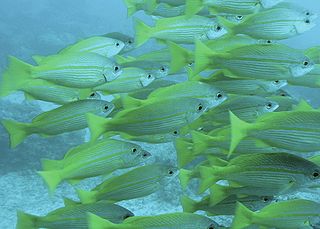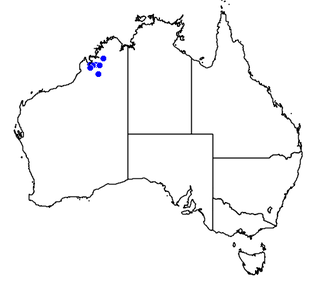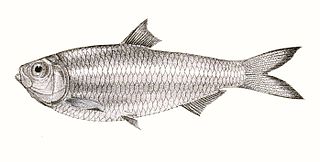
The white bass, silver bass, or sand bass is a freshwater fish of the temperate bass family Moronidae. commonly around 12-15 inches long. The species' main color is silver-white to pale green. Its back is dark, with white sides and belly, and with narrow dark stripes running lengthwise on its sides. It has large, rough scales and two dorsal fins. They are widely distributed across North America, inhabiting large reservoirs and rivers. When mating in the spring, they are more often found in shallow rivers, creeks, and streams. They have been introduced in some places as sport fish and also to predate on nuisance fish, such as gizzard shad. It is the state fish of Oklahoma.

The gafftopsail catfish is found in the waters of the western central Atlantic Ocean, as well as the Gulf of Mexico and the Caribbean Sea. It has long, venomous spines which can cause painful wounds. It feeds on crustaceans and other fish. The male of the species fertilizes the eggs of the female, and broods them in his mouth until they hatch. The gafftopsail feeds throughout the water column. This fish is a common catch in the Southeastern US, although it may be found as far north as New York. They are considered strong fighters by anglers. They are taken from piers, jetties, reefs, and the surf, as well as bottom fishing or flats fishing. They are caught with hard lures as well as soft plastics, cut bait, and live or dead shrimp. Some fishermen use traps for catfish, a method regulated by some states.
Nasus is Latin for nose or snout, and appears in many related terms.

The American gizzard shad, also known as the mud shad, is a member of the herring family of fish, and is native to large swaths of fresh and brackish waters of the United States of America. The adult has a deep body, with a silvery-green coloration above fading to plain silver below. The gizzard shad commonly resides in freshwater lakes, reservoirs, rivers, and streams, but can reside in brackish waters, as it does on the Atlantic coast of the United States. Their range is across most of the continental United States, although they typically go no further north than New York and no further west than New Mexico. They are a large part of many of the ecosystems they inhabit, and can drive changes in phyto- and zooplankton, thereby indirectly affecting other planktivorous fishes. The gizzard shad has been widely used as a food source for game fish, with varied success in management and effectiveness.

The thornback ray, or thornback skate, is a species of ray fish in the family Rajidae.

The bigeye snapper, also known as the bigeye seaperch, red sea lined snapper, golden striped snapper, rosy snapper, yellow snapper, or simply snapper, is a species of marine ray-finned fish, a snapper belonging to the family Lutjanidae. It is native to the Indian Ocean and the western Pacific Ocean. It is the type species of the genus Lutjanus.

The Malabar trevally, also known as the Malabar jack, Malabar kingfish or nakedshield kingfish, is a species of large inshore marine fish of the jack family, Carangidae. It is distributed throughout the Indian and west Pacific Oceans from South Africa in the west to Japan and Australia in the east, inhabiting reefs and sandy bays on the continental shelf. The Malabar trevally is similar to many of the other species in the genus Carangoides, with the number of gill rakers and the grey-brown colour of the tongue being the diagnostic features. The Malabar trevally is a predator, taking a variety of small fish, cephalopods and crustaceans. The species is of minor economic importance throughout its range, caught by a variety of net and handline methods.

The cleftbelly trevally, also known as the cleftbelly kingfish, Kuweh trevally or thin crevalle, is a species of tropical marine fish of the jack family, Carangidae. The species inhabits coastal waters throughout the Indo-West Pacific region from South Africa in the west to Japan in the east, often found near the water's surface. The cleftbelly trevally is the only member of the genus Atropus and is distinguished by a number of anatomical characteristics, with a deep median groove in the belly giving the species its common name. It is not a large fish, growing to a maximum recorded length of 26.5 cm. Cleftbelly trevally are predatory fish, taking a variety of small crustaceans and fish. The species is of minor importance to fisheries throughout its range.

Apogon imberbis, the cardinalfish, the Mediterranean cardinalfish or king of the mullets, is a species of ray-finned fish, a cardinalfish belonging to the family Apogonidae. It is widely distributed in the Mediterranean and along the warm temperate and tropical eastern Atlantic coasts from Portugal south to the Gulf of Guinea.

The bartail flathead, also known as the Indian flathead, gobi or Indo-Pacific flathead, is a species of largely marine ray-finned fish belonging to the family Platycephalidae, the flatheads. This species is found in the Indian Ocean and the Western Pacific Ocean, and has invaded the eastern Mediterranean Sea.

Toxotes kimberleyensis is a species of archerfish found in the Kimberley region of Western Australia. It was first named by Gerald R. Allen in 2004, and is commonly known as the Kimberley archerfish, largescale archerfish, or western archerfish.

The honeycomb grouper, also known as black-spotted rock-cod, common birdwire rockcod, dwarf spotted rockcod, dwarf-spotted grouper, honeycomb cod, wire-netted reefcod or wire-netting cod, is a species of marine ray-finned fish, a grouper from the subfamily Epinephelinae which is part of the family Serranidae, which also includes the anthias and sea basses. It has a wide Indo-Pacific distribution where it is found in coastal and offshore reefs in shallow waters.

Nematalosa is a genus of gizzard shads in the fish family Dorosomatidae. There are currently 11 recognized species.

Agonus is a monospecific genus of ray-finned fish belonging to the subfamily Agoninae in the family Agonidae. Its only species is Agonus cataphractus, commonly known as the hooknose, pogge or armed bullhead. This is a demersal fish found in the coastal waters of the northeastern Atlantic Ocean.

Epinephelus ongus, the white-streaked grouper, specklefin grouper, lace-finned rock-cod, specklefin rockcod, wavy-lined tock-cod, white-speckled grouper or white-spotted rock-cod, is a species of marine ray-finned fish, a grouper from the subfamily Epinephelinae which is part of the family Serranidae, which also includes the anthias and sea basses. It has a wide Indo-Pacific distribution and it is found in brackish waters as well as marine reefs.

The Indian Scad, also known as the Northern mackerel scad, round scad, Russell's mackerel scad, slender scad or the three lined grunter, is a species of ray-finned fish of the genus Decapterus which is part of the family Carangidae and which occurs in the Indian Ocean. It has colonised the eastern Mediterranean through the Suez Canal. It is an important species in coastal fisheries throughout its range.
Sphyraena sphyraena, also known as the European barracuda or Mediterranean barracuda, is a ray-finned predatory fish of the Mediterranean basin and the warmer waters of the Atlantic Ocean.

The white sardine is a species of fish in the family Clupeidae. It was described by Achille Valenciennes in 1847. It is a tropical fish of the Indo-Pacific distributed from Thailand to Indonesia and Australia. Other common names include deep herring and northern herring.

The black pomfret is a species of carangid native to reefs of the Indian Ocean and western Pacific Ocean. This species is very important to local fisheries and is the only known member of its genus.
Nematalosa flyensis, the Fly River gizzard shad, is a species of freshwater ray-finned fish within the family Clupeidae. The species is endemic to Papua New Guinea, and is only known to inhabit the Fly and Strickland Rivers.


















